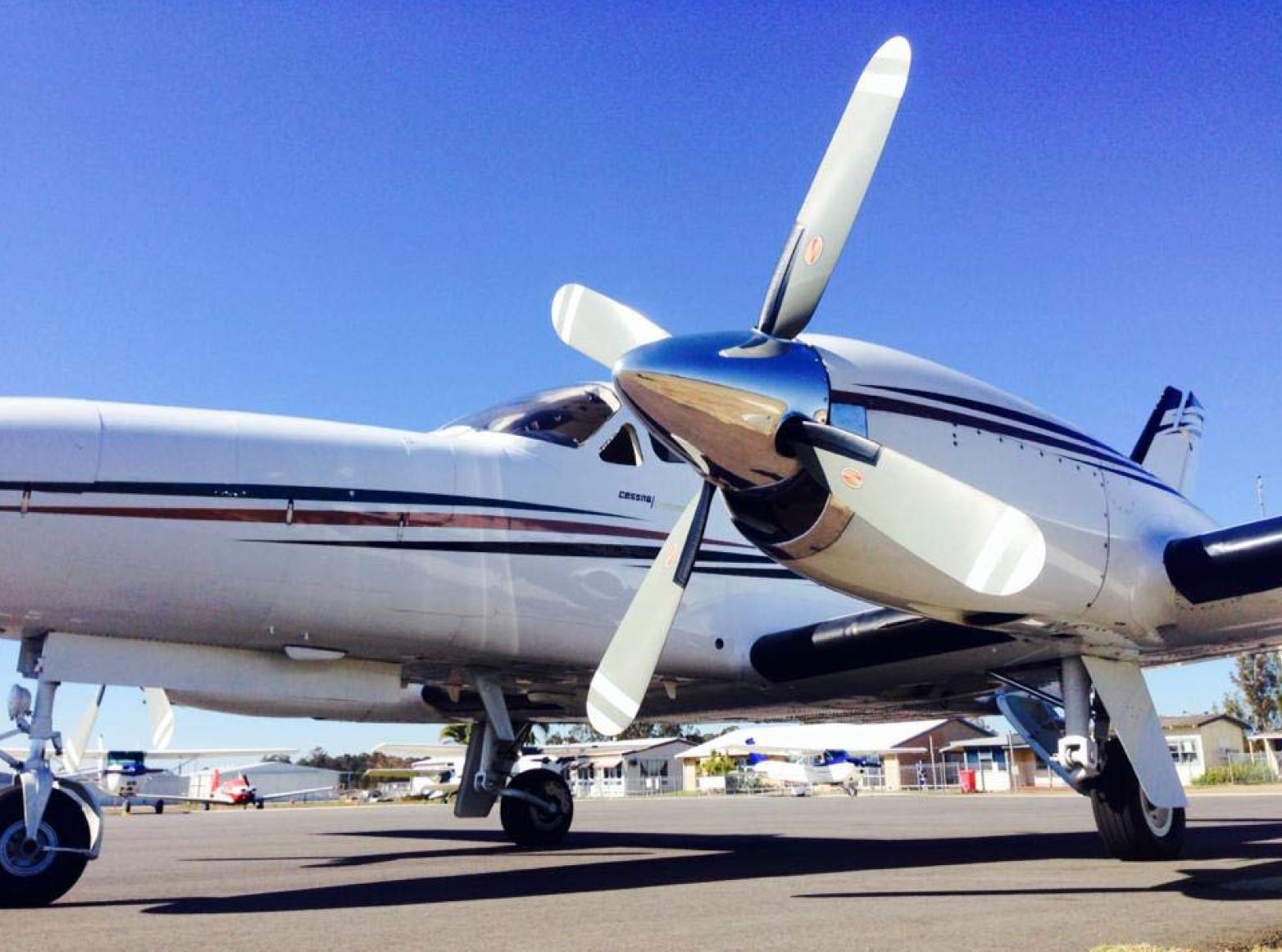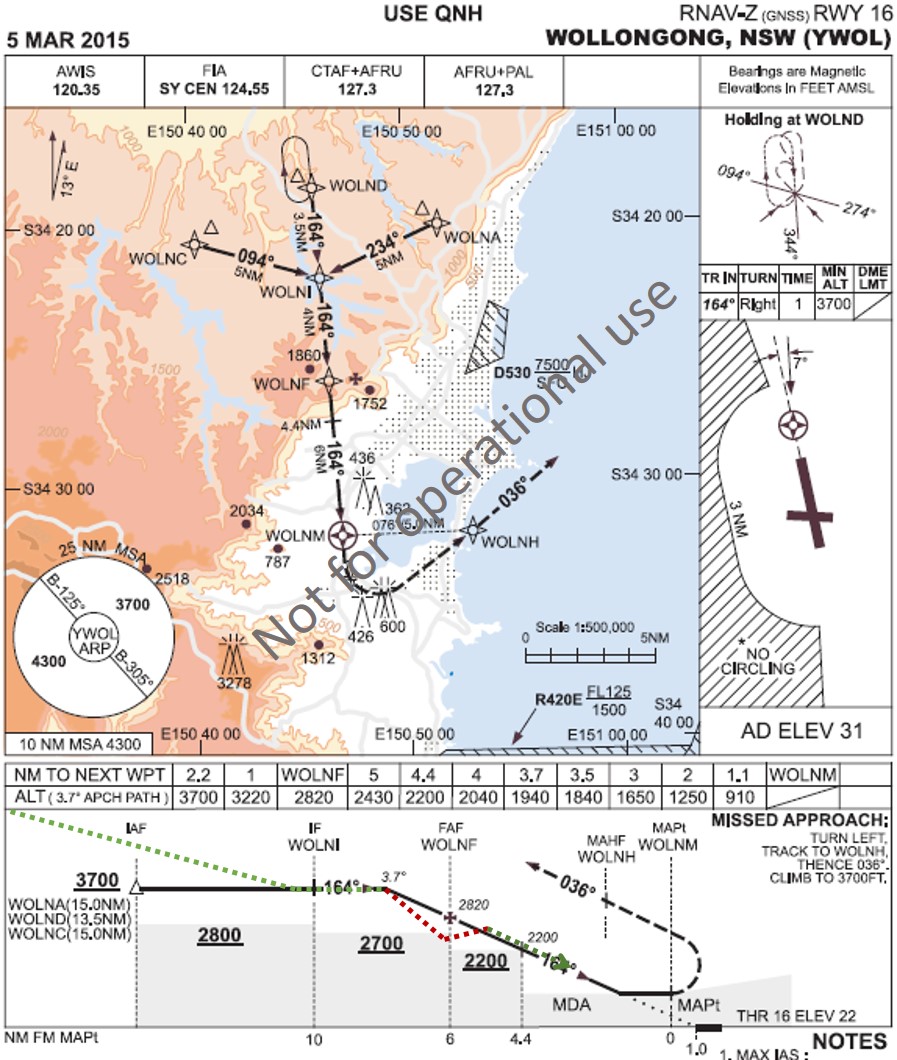What happened
On 3 August 2015 at about 0410 Eastern Standard Time (EST), a Cessna 441 aircraft, registered VH-EQU, departed Scone Airport for a positioning flight to Illawarra Regional Airport (Wollongong Airport), New South Wales. The flight was to be conducted as a multi-crew operation with the pilot flying (PF) occupying the left seat, and the pilot monitoring (PM) occupying the right seat.
Prior to departure, the pilots conducted a pre-flight briefing noting that the weather forecast for the Wollongong area included a warning for severe turbulence below 8,000 ft. The departure and cruise were uneventful. After commencing descent into Wollongong, the PF briefed the PM for an area navigation (RNAV) instrument approach and landing to runway 16 (Figure 1). The approach was planned to be hand flown in darkness under clear skies with a westerly wind of 25–30 kt, reducing to a light breeze on the ground.
The aircraft arrived overhead position WOLND (Figure 1) at about 5,000 ft on descent to 3,700 ft. Due to the strong westerly wind, flying conditions were turbulent and the PF reported that it was quite difficult keeping the aircraft’s wings level. Approaching WOLNI, the PF levelled the aircraft and maintained 3,700 ft as planned. The aircraft was then slowed down to permit the extension of flap and landing gear.
Figure 1: Cessna 441, VH-EQU

Source: Aircraft owner, modified by the ATSB
In accordance with the approach, the PF recommenced descent at 2.2 NM prior to position WOLNF. Due to the steeper than normal approach path angle (3.7 degrees as opposed to the usual 3.0 degrees), the PF reported establishing a descent rate of about 1,000 feet per minute (fpm). The PM reported that they were expecting a descent rate of about 900 fpm. Air traffic control surveillance data showed the descent rate established was somewhere between 1,000 and 1,500 fpm.
Shortly before WOLNF and as the aircraft approached 2,700 ft, the PM called ‘two thousand seven hundred’ with the expectation that the PF would maintain that altitude until passing WOLNF. However, the descent continued and a few seconds later, the terrain alerting and warning system (TAWS)[1] generated visual and aural ‘CAUTION-TERRAIN’ alerts. These alerts were generated as the system detected that the flight path was projected to come within 300 ft of an obstacle or terrain.
Figure 2: Wollongong RNAV(GNSS) approach to RWY 16 showing approximate flight path profile (green/red dotted line) based on air traffic control surveillance data

Source: Airservices Australia, modified by the ATSB
Pilot flying comment
The PF’s company duties included aircraft charter pilot and flight instructor. The PF’s flying experience included 230 hours operating Cessna 441 aircraft (16 hours in the last 90 days) and 6,930 total flying hours.
The PF recalled working hard trying to keep the aircraft’s wings level, which may have distracted them from monitoring the descent profile adequately. The PF recalled thinking that they may have been slightly low on profile approaching WOLNF, but was startled when the terrain warning sounded. The PF had not participated in any TAWS training, even though they had flown the aircraft (fitted with TAWS equipment) for the previous 12 months.
Pilot monitoring comment
The PM company duties included aircraft charter pilot and flight instructor. The PM’s flying experience included 350 hours operating Cessna 441 aircraft and 3,400 total flying hours.
The PM believed that the when the TAWS alert activated, the aircraft was at an altitude somewhere between 2,600 ft and 2,500 ft and about 0.5 NM before WOLNF. The time between being below 2,700 ft, having the TWAS alert and an appropriate response was less than 10 seconds.
The PM reported having completed TAWS training with a previous employer. The PM believed that following the TAWS warning, they should have applied full power, climbed at maximum rate and conduct a missed approach in accordance with the operator’s procedures.
Fatigue management
Prior to the flight, both pilots had completed 2 days free of duty. They reported being well rested and obtaining about 8 hours sleep each night.
On the morning of the flight, the pilots reported waking up around 0300. They advised that they generally found it counterproductive to try and get to sleep early and therefore only received about 5 hours of sleep.
Despite the limited amount of sleep, both pilots reported being alert during all stages of the flight.
ATSB comment
The aircraft was fitted with a terrain awareness and warning system (TAWS) designed to reduce the risk of flight into terrain. While a TAWS was not required for the particular type of operation, the lack of TAWS training probably explains the nature of the PFs response to the terrain alert.
Pilots and operators of aircraft are encouraged to be appropriately trained in the use of all equipment fitted to their aircraft.
Safety action
Whether or not the ATSB identifies safety issues in the course of an investigation, relevant organisations may proactively initiate safety action in order to reduce their safety risk. The ATSB has been advised of the following proactive safety action in response to this occurrence.
Aircraft operator
As a result of this occurrence, the aircraft operator has advised the ATSB that all pilots now receive TAWS training.
Safety message
Due to the early start combined with inadequate sleep the night before, despite reporting otherwise, the pilots were likely fatigued. Pilots need to be aware that obtaining less than 7-8 hours sleep a night increases the risk of operating with a level of fatigue known to have a demonstrated effect on performance.
Pilots also need to consider the effect flying in the early hours of the morning has on their performance. Their body is in a circadian low period which could lead to periods of impaired alertness and delayed reaction times.
The ATSB continues to be concerned about flight below minimum descent altitudes. When conducting an approach in instrument meteorological conditions, which includes darkness, pilots must ensure the approach is conducted in accordance with the prescribed procedure. In this case, the pilots were required to manage the vertical profile to ensure the aircraft remained at or above the minimum descent altitude, thereby ensuring clearance from terrain and obstacles.
Descent below the minimum descent altitude compromises the minimum terrain clearance requirements and increases the risk of controlled flight into terrain (CFIT).

Aviation Short Investigations Bulletin - Issue 49
Purpose of safety investigationsThe objective of a safety investigation is to enhance transport safety. This is done through:
It is not a function of the ATSB to apportion blame or provide a means for determining liability. At the same time, an investigation report must include factual material of sufficient weight to support the analysis and findings. At all times the ATSB endeavours to balance the use of material that could imply adverse comment with the need to properly explain what happened, and why, in a fair and unbiased manner. The ATSB does not investigate for the purpose of taking administrative, regulatory or criminal action. TerminologyAn explanation of terminology used in ATSB investigation reports is available here. This includes terms such as occurrence, contributing factor, other factor that increased risk, and safety issue. Publishing informationReleased in accordance with section 25 of the Transport Safety Investigation Act 2003 Published by: Australian Transport Safety Bureau © Commonwealth of Australia 2016
Ownership of intellectual property rights in this publication Unless otherwise noted, copyright (and any other intellectual property rights, if any) in this report publication is owned by the Commonwealth of Australia. Creative Commons licence With the exception of the Coat of Arms, ATSB logo, and photos and graphics in which a third party holds copyright, this publication is licensed under a Creative Commons Attribution 3.0 Australia licence. Creative Commons Attribution 3.0 Australia Licence is a standard form licence agreement that allows you to copy, distribute, transmit and adapt this publication provided that you attribute the work. The ATSB’s preference is that you attribute this publication (and any material sourced from it) using the following wording: Source: Australian Transport Safety Bureau Copyright in material obtained from other agencies, private individuals or organisations, belongs to those agencies, individuals or organisations. Where you wish to use their material, you will need to contact them directly. |
__________
- The TAWS included a forward-looking terrain avoidance function along and below the aircraft’s lateral and vertical flight path. In the event of a potential conflict with terrain, the system provided the pilots with visual and aural alerts.


